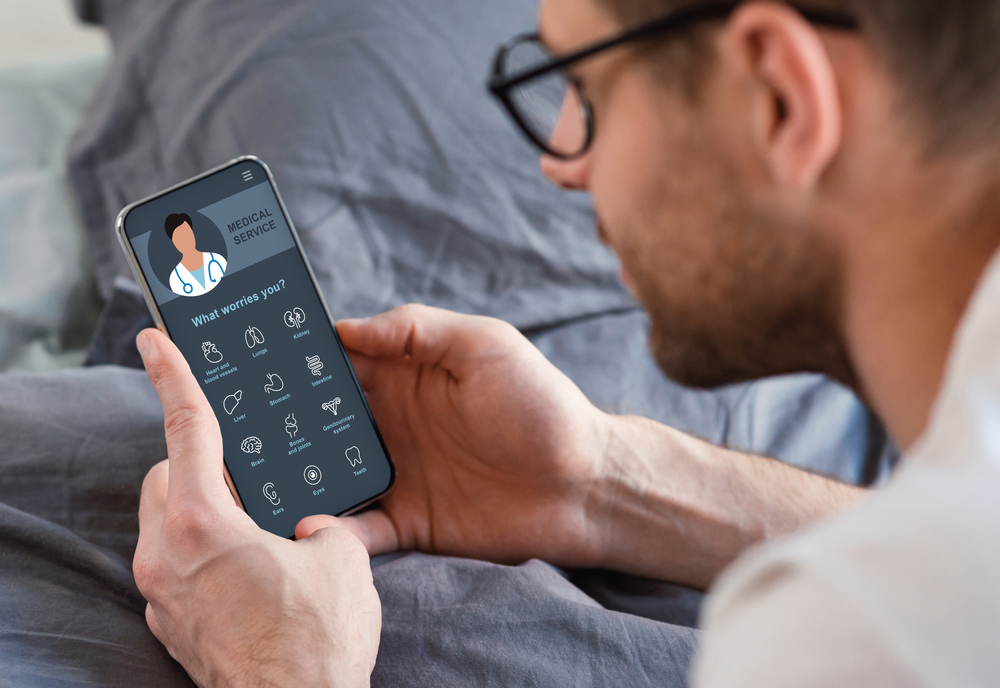As healthcare providers of all sizes are actively adopting custom patient engagement software in their practices the market is set to increase more than threefold by 2027. This growth is partly driven by patient demand. Indeed, research shows that more than a quarter of patients would switch to a new provider for better digital services.
Patient engagement software delivers a seamless experience, from patient registration to post-visit feedback. But the benefits of modern engagement technologies aren’t limited to the patient side only—they offer plenty to providers as well.
At Demigos, years of hands-on experience in full-cycle health tech development have shown us that patient engagement tools can transform healthcare practice. There’s a lot to consider before you take the leap, though. In this guide, we’re going to give you the lowdown on software benefits for both patients and providers, discuss the latest market trends, and suggest tips on patient engagement platform development—what features to add and how to overcome implementation challenges.
So let’s get started!
What is patient engagement software?

Patient engagement software includes tools to automate administration, improve communication channels between the provider and the patient, and offer patient education and assistance. The use of these tools strengthens patient involvement, encourages better care outcomes, and when properly implemented, provides a seamless patient experience.
With a shift toward value-based incentives in reimbursement models, patient satisfaction and experience are rapidly becoming key considerations for healthcare practices. Here’s the difference between these two terms:
-
Patient satisfaction is how patients feel about the care they receive
-
Patient experience is a broader term that reflects patient satisfaction with all interactions across the health care system
Modern patient engagement software aims to make patients more involved in their health care, as well as facilitate fast and efficient access to services. This can positively affect patient satisfaction and experience and help practices adopt improved healthcare processes. Let’s explore this in more detail.
How patient engagement software improves healthcare processes

Today, patient engagement solutions are complex platforms that automate and simplify many health care operations. Let’s look at the essential functions.
Automated scheduling
Patient engagement software enables self-scheduling online or on mobile devices without the need to complete forms or submit payee information every time. Most of the processes are automated for both patients and providers, including registration, reminders, and push notifications about schedule changes.
Simplified billing and payment
With patient engagement software, providers can make the payment collection process simpler and faster. Options include quick payments, recurring automated payments, and mobile-first billing, allowing patients to pay in minutes.
Marketing and information campaigns
Automated mass messaging, emails, and calls reduce manual work for medical staff. They can be used to inform patients of newly available services, vaccines, and tests. They may include direct links to self-scheduling options or patient portals for convenience. Embedded codes can also track patient activity and detect which services a patient is interested in.
Collection of post-visit patient feedback
Patient engagement software automatically sends messages requesting patient feedback immediately after appointments. These messages can be very interactive, making it easier and faster for patients to leave a comment.
Although streamlining healthcare operations is already a great reason to develop a patient engagement platform, there are many other benefits. Let’s talk about them in more detail.
Benefits of creating a patient engagement platform

Patient engagement software has clear benefits for both patients and providers. So, when developing patient engagement software, you can get the following advantages.
Better care outcomes
Patient engagement software enables 24/7 access to care through virtual chatbots and instant messaging with practitioners, nurses, and wellness coaches. It also provides science-based resources about a patient’s medical condition and advice on nutrition, fitness, lifestyle, and rehabilitation. Often, this software engages patient family members in participating in care plan management as well.
As a result, patients are more informed about their health, visit their doctors regularly, and tend to adhere to their medication plans better.
Higher provider productivity
Automated scheduling, messaging, and billing not only help providers keep their schedules full but also take non-skilled routine work away from medical staff, leaving more time for skilled tasks. Automation also reduces the incidence of human errors.
Online registration and virtual waiting rooms mean patients don’t wait for or make appointments onsite so providers can avoid crowding. What’s more, the software allows providers to extend their patient outreach and demographics by engaging patients digitally, even at touchpoints that previously required patients to appear at hospitals or clinics in-person (for example, during registration, check-in, or in the waiting room).
Cost reduction and added revenue
While automated routine tasks and more efficient billing offer immediate cost reductions, the benefits extend beyond this.
Providers can retain existing clients by enhancing communication and delivering more personalized care based on regular patient surveys and data analytics visualized on dashboards. This improves patient satisfaction scores and increases the use of patient portals—two factors that affect reimbursement incentives.
Improved management of private health data
Engagement software allows patients to manage their privacy by tailoring what information they share. This gives patients better control over their health records and improves data security by providing an extra layer of protection.
If you have no doubts that patient engagement solutions are what your medical organization needs, it’s time to proceed to the development stage. When considering how to build your patient engagement software solution, it can be helpful to look at market trends to identify new areas of interest and ways to maximize your investment.
Patient engagement software: Market trends

Following the pandemic, 60% of patients want to communicate with providers and manage their conditions through technology, so it’s no wonder that the demand for patient engagement software development is growing. Here are main trends to pay heed to if you want to keep pace with the changes:
A holistic approach to patient engagement
Multiple apps for your hospital or clinic can lead to confusion all round. Instead of separate applications for appointments, remote monitoring, e-prescriptions, and so on, many providers now choose to build a convenient all-in-one platform that manages most interactions between the provider and patients.
The use of advanced technology
Research predicts that artificial intelligence (AI) in the healthcare market will grow at a rate of 41.8% from 2021 to 2028. Meanwhile, the global Internet of Things (IoT) healthcare market is expected to double by 2025, compared to 2018. Patient engagement software collects and processes mountains of patient data, so IoT and tools for data visualization and analytics are essential for both providers and patients to make data-driven decisions.
Improved accessibility
In 2020, nearly $1.4 billion was invested in mHealth applications, making them the third best-funded digital health technology worldwide. Nowadays, many patients prefer to get and process information via their smartphones, so making a mobile version of your software is necessary to meet patient expectations.
Along with mobile optimization, an intuitive interface and streamlined data sharing help to simplify and improve accessibility.
Remote patient monitoring
The rise of telemedicine and virtual care has triggered the rapid adoption of remote patient monitoring tools. These allow providers to monitor patients’ health parameters, identify risks, and prevent complications by detecting erratic patterns—all of which is particularly important for chronic disease management.
Patients are generally amenable to adopting wearable health monitoring devices. Regular monitoring results in better overall awareness of their health or condition and better medication compliance.
So, consider integrating your patient engagement software with health tracking devices, including wearables for tracking physical activity, blood pressure, glucose level, heart rate, mood, sleep, and so on.
Personalization
Nearly 75% of U.S. patients want their healthcare experiences to be more personalized. Providers can lose patients by ignoring their individual needs, especially when it comes to communication between the patient and the provider.
You can achieve more personalization by allowing multiformat educational tools depending on a patient's preference, be it text, video, audio, visuals, or offering a virtual assistant. Predictive health care powered by AI and machine learning can help providers to generate more personalized treatment plans and prescribe more effective medications.
Cloud deployment
Cloud-based apps enable secure remote access regardless of the device type. The improved data protection, detailed activity tracking, powerful backup tools, high availability, and scalability are what make cloud deployment a “gold standard” of health tech.
These market trends show that the functions of a patient engagement system aren’t limited to patient education and communication enhancement. The demand for all-in-one solutions makes this type of software feature-rich. So, what platform functionality is suitable for your practice?
Key features of custom patient engagement platforms

If you want to build a patient engagement solution that can handle most interactions between providers and patients, you must ensure that it’s secure, HIPAA-compliant, and preferably includes the following core features.
Interactive real-time communication
Provide secure communication through Q&A sections, “Ask your doctor” features, and instant messaging. Ensure that patients have 24/7 access to medical staff.
Appointment scheduling
This includes appointment scheduling and rescheduling, online self-registration and check-in, automatic new patient registration, reminders, and updates (text or voice messages). Also, make sure that your software collects post-visit feedback.
Telehealth and virtual waiting rooms
The COVID-19 pandemic has driven custom patient engagement software development that addresses the need for telehealth and virtual waiting rooms. Instead of waiting in hospitals, patients can notify medical staff of their arrival via smartphones and stay in the car or outside the clinic until the doctor is available. With this software, patients can also make a telehealth appointment and receive a consultation through their apps. So don’t forget to include these features in your solution.
Online payments
These features should allow providers to send electronic invoices, offer autofill for payment information, etc. Patients should be able to pay online by choosing from different payment options, check their transaction history and invoices, automate recurring payments, and so on.
Tools for patient education
Patient engagement software should use customized educational content in multiple formats and integrate social media. With its help, patients should be able to ask questions, receive consultations, or get information about their symptoms and medical conditions via live chats, Q&A sessions, chatbots, or virtual assistants. So ensure that your software offers interactive education tools.
Also, consider including gamified elements (challenges, achievements, badges, etc.) and the possibility of adding family members for better engagement and extra motivation. Use surveys and feedback to adjust the software to patient desires, bearing in mind that these aren’t always aligned with your goals.
Integrations with other solutions
Your software should drive users to the patient portals, integrate with other systems like EHR or CRM, applications, and vendors (for example, integration with medication tracking apps or Uber Health for ride scheduling).
Read also: Benefits and Features of Healthcare CRM Software
Other patient engagement software features may include a secure exchange with lab staff to get test results, telehealth, prescription refill request forms, and multilingual support.
This isn’t an exhaustive list of all possible features, of course, but it covers the essentials. In the next section, we’ll talk about the challenges you can face when adopting ready-made or custom patient engagement software and how to overcome them.
Challenges of implementing patient engagement software

Patient engagement software helps providers build stronger relationships with patients while improving care outcomes and reducing costs. Yet, if it’s so great, why hasn't every provider adopted it? There are several challenges you need to know about.
Cost
Patient engagement software can be expensive, which is a common challenge for medical organizations. Monthly subscriptions for ready-made solutions can cost up to $350. Custom patient engagement software development also requires a significant investment, but it’s a more affordable option in the long run since it doesn’t make you dependent on the vendor’s pricing.
Privacy concerns
Patient engagement software will deal with patient health records, so data security should be a top priority. Choose vendors that comply with GDPR and HIPAA at least. Also, be cautious when working with ready-made solutions. These are usually the weakest option as they aren’t tailored to your databases and workflow, which increases the possibility of data leakage.
Workflow integrity
Software should help you create a more effective workflow by aligning with your long-term strategy and addressing the goals you want to achieve. For small practices that require only basic functionality, ready-made solutions might be a good option, while for bigger organizations, custom software is the best choice to guarantee workflow integrity.
Medical staff resistance
The more complex the software you want to implement, the more time and effort you’ll need to spend on staff training. Opt for solutions that have a very intuitive interface and are easy to use. After all, who wants to spend ages searching for the right button to tap? A poor interface risks staff becoming frustrated and perhaps unable to see the benefits of the new system.
To overcome the above challenges, organizations develop a custom patient engagement system that is fully tailored to their particular needs and technical capabilities. Custom healthcare development provides more reliable data security and integrates with your existing workflow.
Developing patient engagement software with Demigos
Custom patient engagement software is no longer a platform solely for communication and digital coaching. Nowadays, it unlocks many more benefits for both patients and providers. Patients can increase their awareness of their health and lifestyle and improve on medication adherence, while providers can optimize healthcare operations and achieve better treatment outcomes at less cost.
Providers who want to stay afloat and adapt to the rapidly changing digital environment usually decide to create patient engagement software from scratch. Whether you need feature-rich software and unique functionality or want to tailor the software to your specific workflow, Demigos can help.
As a top Clutch developer, at Demigos we know how to build secure healthcare solutions from scratch. With our dedicated focus on health tech and extensive experience in this field, we know how to develop software that both your patients and coworkers will find easy to adopt and engage with.
Contact us today to discuss your project!






